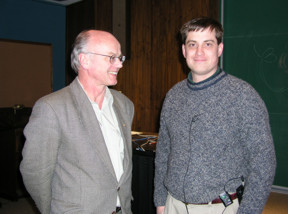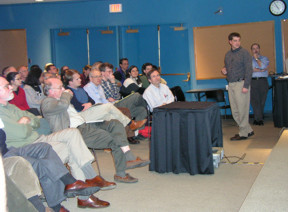On Tuesday, February 11, NASA released the first results from WMAP - the Wilkinson Microwave Anisotropy Probe - which uses technology designed and built by the Central Development Lab of Charlottesville's own National Radio Astronomy Observatory (NRAO) to study the faint afterglow of the Big Bang.
The press conference was broadcast live at NRAO headquarters so the observatory's scientists and engineers could see how their instruments helped NASA scientists look for very tiny temperature fluctuations, or anisotropy, in the cosmic microwave background radiation.
A short 300,000 years after the universe began in a cataclysmic burst of energy and matter called the Big Bang, things had finally cooled off enough to allow light to travel through the cosmos. Today, nearly 14 billion years later, that light is still visible as the cosmic microwave background radiation. This radiation, however, is very cold, just a few degrees above absolute zero (-273 degrees Celsius, or 0 degrees Kelvin).
It takes amazingly sensitive and sophisticated devices, called low-noise amplifiers, to detect and measure this radiation. NASA's WMAP Explorer contains 80 low-noise amplifiers that were made by the NRAO. These amplifiers are so sensitive that they are able to measure temperature differences as small as 0.00002 degrees Kelvin between two points on the sky.
By studying these minute fluctuations in the temperature of this background radiation, scientists were able to see the very first structures in the universe, and to learn how the young universe looked at a time before galaxies formed. This research will help scientists decipher the enigmatic evolution of the universe from a remarkably hot and dense fireball, to the vast collection of stars, galaxies, and planets that we see now in outer space.
WMAP was launched on June 30, 2001, and continues to observe the sky from an orbit about the L2 Sun-Earth Lagrange point, 1.5 million kilometers from Earth. Lagrange points are positions in space where the balance of gravitational pulls from two large masses (like the Earth and the Sun) enables an object like the space probe to maintain the same position relative to the two masses.
Details of the NASA press conference.
More information on WMAP can be found on the WMAP homepage.
 | Marian Pospieszalski (left), from NRAO's CDL, leader of the team that developed the HFET amplifiers that made the NASA WMAP mission possible and Edward Wollack (right) former NRAO staff member, now on the NASA WMAP mission team. |
 | Edward Wollack of NASA/Goddard Space Flight Center speaking to an NRAO audience in Charlottesville (2/13/03) on the WMAP results. |
